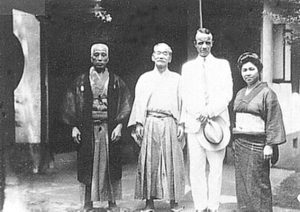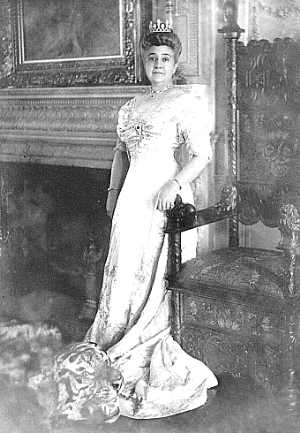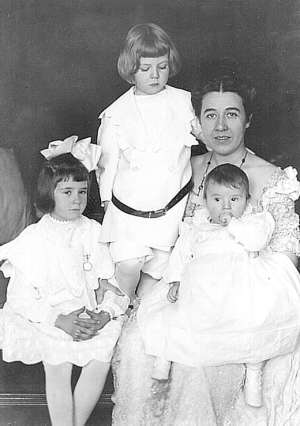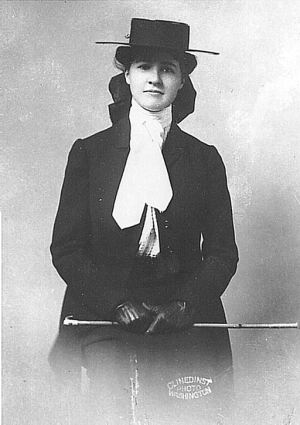From Sandow's Magazine, December 7, 1905
Article contributed by Richard Bowen. Annotations by Joseph R. Svinth. Photos courtesy Lee Norton. Text and photos copyright © EJMAS 2000. All rights reserved.
A little time ago, in America, a hostess created a sensation -- always a social triumph in the States -- by a surprise party. The guests, on arriving, were shown to dressing-rooms, where waiting-maids persuaded them to change their smart apparel for a curious loose costume, consisting of white linen knickerbockers and jackets, with loose white linen wrappings for their feet. Later they descended to a large hall, on which thick mats were laid --as if a soft mattress which had been spread all over the floor. First there was a demonstration of jiu-jitsu by two little Japanese ladies, and then there were lessons for everyone. The idea was accepted with delight, and soon the Japanese national game -- pronounced by them without sounding the final vowel -- became the fashionable exercise with smart women.
It is now introduced into our own country [Britain] in more prosaic fashion, and promises to create an interest little less than in America, and possibly more abiding. At first sight the game appears more wonderful than attractive. Charming it would doubtless be to possess the knack of throwing a powerful opponent almost as if he were a bag of thistledown. Thwack, smack, bump, flop on the mattress, however, demonstrates that he is no such thing, and as the falls are not all on one side, a spectator may be pardoned for thinking tenderly of her bones. A larger knowledge, however, leads to the fact that bones are quite safe. The first thing taught is how to take a fall; the mind is kept always in attendance on the body in jiu-jitsu, and falls are taken on the fleshy pads. In this way, even when they occur on a hard pavement, a bruise is the worst result; when on the mattress there is no result at all. The girl who knows jiu-jitsu throws and is thrown as if she were made of india-rubber. The skilled demonstrators move with almost lightning rapidity, except when showing some special part of the game. The whole idea of it is quickness and knack. Physical strength has no part in it; the greatest difficulty with pupils is to train them to refrain from using any. To the uninitiated it is marvellous to note that a girl, slight and lissom, can throw a large man over her shoulder and across her hips with perfect ease, and with the grace inseparable from power. It is clearly demonstrated that to put out strength is to give a skilled jiu-jitsu adversary an advantage at once seized to procure a throw. The body must be kept limber and supple.
Besides the art of throwing, the game consists in a series of locks, the use of which compels an adversary to surrender. These are accomplished by strain on a joint or pressure on a nerve, which soon becomes unbearable. In the game no attempt is ever made to give pain. If used for defence, the locked adversary would either have to give in or have an arm or leg broken; pressure on a nerve would reduce him simply by being so excruciatingly painful.
***
Editor's notes: In early 1904 G.P. Putnam's Sons published Physical Training for Women by Japanese Methods by H. Irving Hancock. Hancock was a New York journalist who worked for Leslie's Weekly until 1901, at which point he quit to begin churning out children's books and the occasional physical culture text.
According to an advertisement for Physical Training for Women published in the New York World on March 20, 1904, "Jiu-jitsu has been practiced by the Japanese for 2500 years. Jiu-Jitsu means 'muscle making.' Jiu-jitsu is easily learned." While that’s three lies in three sentences, it was obviously Madison Avenue's idea of truth, as the same lies are still told today.
The jujutsu that Hancock showed was probably Tsutsumi Ryu, as that was the style practiced by a Japanese wrestler, Katsukuma Higashi, whom Hancock promoted in the US. In Physical Training for Women Hancock describe his exposure to women's jujutsu as follows:
"You like see what Japanese woman can do?"
I assured him that it would give me great pleasure to have such an exhibition…
She was laughing as she approached, … a supple young woman bounding with the vim of life, and graceful in every line of contour.
While I stood looking at her, the little woman halted before me, made a polite bow, and then backed away, in the manner that is common to students of jiu-jitsu when inviting combat. She was fully six inches shorter than I and at a great disadvantage in point of weight…
I bowed, and we backed off a little way, then approached each other sinuously, each looking for an opening. There was a clinch that lasted, as nearly as I could judge, about five seconds. Three seconds later I was compelled to pat the floor in token of surrender. There were five bouts in all, of which I secured the distinction of winning one…
But in Washington, Yamashita did not end up teaching James Nathan Hill, but instead President Theodore Roosevelt. As 1904 was an election year, the incumbent Republican president used his judo training to elicit favorable press coverage. This outraged Martha Blow Wadsworth, an heiress who wintered in Washington (her Massachusetts Avenue mansion is presently a museum) and spent her summers at her horse farms in upstate New York (the family archives are at Milne Library at SUNY Geneseo).
Wadsworth truly, deeply, and profoundly despised Roosevelt. Indeed, she despised him so much that she insisted on duplicating virtually every physical feat he claimed, once riding a relay of fast horses several hundred miles in 24 hours just to spite him. Therefore she wasted no time organizing women's judo classes with Yamashita's 26-year old wife Fude. After several months of practice, reporters were notified, and on May 29, 1904, the New York World featured the class in its Sunday supplement.

Yoshitsugu (Yoshiaki) Yamashita, Jigoro Kano, Kermit Roosevelt, and Fude Yamashita in Japan, mid-1920s. Photo from Joseph Svinth collection. Copyright © 2000 All rights reserved.
Wadsworth was not the only woman with an ax to grind with Roosevelt; another student was Louise "Hallie" Davis Elkins, who was the daughter of the man who ran for vice-president on the Democratic ticket in 1904 and the wife of Senator Stephen Benton Elkins. Davis-Elkins College in West Virginia is named for the families involved.

Maria Louise ("Hallie") Davis Elkins (Mrs. Stephen Benton Elkins, 1854-1933)
Besides Martha Wadsworth and Hallie Elkins, other members of Mrs. Yamashita’s Washington judo class included:

Grace Davis Lee (Mrs. Arthur Lee, 1869-1931), with three of her children circa 1905. Left to right: Ellen Bruce Lee, Henry Davis Lee, Arthur Lee, Jr. Photo courtesy Lee Norton © 2000 All rights reserved.

Katherine Hallie Elkins (Mrs. William F. Hitt, 1886-1936), circa 1905. Photo courtesy Lee Norton © 2000 All rights reserved.
Re Lewis Smith Wilmer. Re Wilmer was the wife of a distinguished Washington opthamalic surgeon named William Holland Wilmer.
A Note on Sources
For more about Roosevelt and Yamashita, see Joseph R. Svinth, "Professor Yamashita Goes to Washington," Aikido Journal, 25:2 (1998), 37-42. Sources of biographical data for the Hill family include John E. Tuhy, Sam Hill: The Prince of Castle Nowhere (Beaverton, OR: Timber Press, 1983), 71. Sources of similar data for the women in Wadsworth's judo class include Irene A. Beale, Genesee Valley Women (Geneseo, NY: Chestnut Hill Press, 1985), 139-145; Biographical Directory of the United States Congress 1774-1989, edited by Kathryn Allamong Jacob and Bruce A. Ragsdale (Washington, DC: Government Printing Office, 1989); National Cyclopaedia of American Biography; Who Was Who in America; "Henry G. Davis" in Presidential Also-Rans and Running Mates, 1788-1980, compiled by Leslie H. Southwick (Jefferson, NC: McFarland, 1984), 420-427; Letter from Lee Norton (granddaughter of Grace Davis Lee), September 24, 1997; Los Angeles Times, March 19, 1933, Pt. I, 3; Sharon Collins Park and Judith Lanius Sussman, "The Wadsworth House: An Historical Perspective," (Washington, DC: Wadsworth Preservation Fund, 1992); and letter from Lee Yahrmarkt (Borderland State Park), November 4, 1997.
Financial support for research involved in preparing this article included a grant from the King County Landmarks and Heritage Commission.